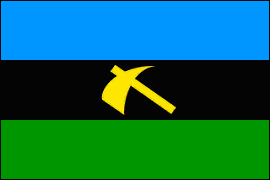|
EAST AFRICA
PROTECTORATE
COLONY & PROTECTORATE OF KENYA REPUBLIC OF KENYA |
|
The Colony and Protectorate of Kenya
consisted of the territory formerly administered by the Imperial
British East African Company (chartered in 1888) plus part of the
mainland territory of the Sultanate of Zanzibar (see below). The
former was the colony; the latter was the protectorate. The IBEAC
was never profitable and between 1893 and 1895 it relinquished its
leases to the British government. Up to 1920 the colony thus created
was formally titled the East Africa Protectorate and was informally
known as British East Africa, but in 1920 the name Kenya was
adopted. At that time the colonial ensigns and flags, which
displayed the badge of the IBEAC, were changed to display Kenya's
new badge, the red lion rampant. The Kenya Red Ensign is generally
considered to have been unofficial but it may have been authorized
for ships registered in the protectorate as opposed to the colony
proper, which was British territory and whose ships
used an undefaced Red Ensign.
Kenya achieved
independence in 1963, the protectorate being merged into the colony.
It was a British dominion for one year and then became a
republic, though remaining a member of the British Commonwealth of
Nations. The national flag was adopted in 1963, its design being
adapted from that of the flag of the Kenya African Union, the
country's major pre-independence political party.
The flag's colors symbolize the Kenyan people
(black), the blood shed in the struggle for independence (red), the
country's natural wealth (green), and peace (white). The defense of
freedom and independence is symbolized by the shield and two spears.
|
|

British East Africa Government Ensign
1895-1920 |

British East Africa Civil Ensign 1895-1920 |
|

British East Africa
Commissioner's Flag 1895-1906 Governor's Flag 1906-20 |
|

Colony & Protectorate of Kenya Government Ensign
1920-63 |

Colony & Protectorate of Kenya Unofficial Civil Ensign
1920-63 |
|

Colony & Protectorate of Kenya Governor's Flag 1920-63 |
|

Kenya African Union |

Republic of Kenya Since 1964 |
|
UGANDA
PROTECTORATE REPUBLIC OF UGANDA |
|
British involvement
in Uganda dates from 1890, when the Imperial British East Africa
Company attempted to mediate among the various religious
factions (Pagan, Protestant, Catholic, Muslim) in Buganda,
Uganda's largest kingdom or chieftainship, where a civil war was
underway. When the company announced its intention to withdraw
from Uganda, British missionaries asked the
British government to intervene, arguing that civil war was
likely to break out afresh and spread to other areas. The
government, though reluctant to get involved, eventually agreed
and proclaimed a protectorate over all the kingdoms of Uganda.
The local kings and chieftains retained considerable autonomy,
maintaining law and order and collecting taxes for the British,
whose governing presence was minimal. The chief British official
in Uganda was titled Commissioner up to 1910 and Governor
thereafter.
Until 1914 the only
flag used was the Union Jack but in that year a badge for Uganda
was introduced: the crested crane, a bird indigenous to the
country. This badge appeared on the government ensign and the
Governor's flag but since Uganda was landlocked no Red Ensign
was authorized. Uganda achieved independence in 1962, after
protracted negotiations to reconcile the conflicting interests
of the various chieftainships. The compromise that emerged was
an elective constitutional monarchy with a federal structure, an
unstable arrangement that gave way to a unitary republic (really
a dictatorship) in 1966. Like Kenya, Uganda was a British
dominion for one year after independence and thereafter remained a member
of the British Commonwealth of Nations. The national flag
adopted in 1962 was based on the pre-independence flag of the
Uganda People's Congress Party (UPC), the colors black, yellow
and red representing the Ugandan people, sunshine and
brotherhood respectively. A stylized depiction of the crested
crane is centered on the flag.
Also shown below are
the current flag of the UPC and the flag of the Uganda
Democratic Party, a predominantly Catholic organization. |

Uganda Protectorate
Government Ensign 1914-63 |

Uganda Protectorate
Governor's Flag 1914-63 |
|

Uganda People's Congress Party Flag 1960-66 |

National Flag of Uganda Since 1962 |
|

Uganda People's Congress Party Flag Since 1966 |

Uganda Democratic Party Flag
Since 1954 |
|
TANGANYIKA TERRITORY
(LEAGUE OF NATIONS MANDATE & UNITED NATIONS TRUST TERRITORY)
REPUBLIC OF
TANGANYIKA UNITED REPUBLIC OF TANZANIA |
|
After the Great War, the colony of German East Africa was
partitioned. The small Kionga Triangle bordering Portuguese East
Africa (Mozambique) was ceded to Portugal, the northwestern district
of Ruanda Urundi was handed over to Belgium as a League of Nations
mandate and the rest went to Britain, also as a League of Nations
mandate called the Tanganyika Territory. The League mandates came
into force in 1922. The Tanganyika Territory had flags of the
standard British colonial pattern: for the Governor the Union Jack defaced with the
Territory's badge, the head of a giraffe within a garland; Blue
Ensigns with the same badge for government authorities; and a defaced
Red Ensign for merchant ships registered in the Territory.
Independence came in 1961 and Tanganyika adopted a national flag
with horizontal stripes of green black and yellow, respectively
symbolizing the land, the people and the wealth of the nation. After
one year as a British dominion, Tanganyika proclaimed itself a
republic. In 1964 the union of Tanganyika and Zanzibar (see below)
came into force and the country was renamed the United Republic of
Tanzania. The national flag was altered to a design with diagonal
stripes, blue being added for Zanzibar.
The two major pre-independence parties were the Tanganyika
African National Union and the Marxist Afro-Shirazi Partythe latter
also active in Zanzibar. In 1977
they merged as the Party of the Revolution, which from then until
the constitutional changes of 1992 was the only legally permitted
political party in Tanzinia. It is still the ruling party but now
there is an official opposition in the form of the center-right
Party for Democracy and Progress. |
|

Governor's Flag 1922-61 |
|

Government
Ensign 1922-61 |

Customs Ensign 1925-61 |
|

Civil
Ensign 1922-61 |
|

Republic of Tanganyika
National Flag 1961-64 |

United Republic of Tanzinia National Flag
Since 1964 |
|

Tanganyika African National
Union Flag 1954-77 |

Afro-Shirazi Party 1957-77 |
|

Chama Cha Mapinduzi
(Party of the Revolution) Flag Since 1977
|

Chama
cha Demokrasia na Maendeleo
(Party for Democracy and Progress) Flag since 1992 |
|
ZANZIBAR PROTECTORATE
SULTANATE OF ZANZIBAR
PEOPLE'S REPUBLIC OF ZANZIBAR & PENDA |
|
The Sultanate
of Zanzibar originated as an overseas possession of the Sultanate of
Oman to the north. Previously it had been part of the Portuguese
Empire and as such it became a center of the slave trade. The
Portuguese were driven out in 1698 and the new Arab elite
established a plantation economy, enslaving the native African
population in the process. Besides the slave trade, Zanzibar was
famous for its spices: nutmeg, black pepper, cinnamon and especially cloves. In 1861 it because a
sultanate in its own right, separate from Oman. The territory of the
Sultanate encompassed the islands of Zanzibar and Pemba, numerous
smaller islands, and a narrow strip of land on the African coast
stretching from Cape Delgado in what is now Mozambique to Kipini in
what is now Kenya. Zanzibar's political and economic influence
extended from this coastal zone into the African interior. The flag
of the Sultanate was the same as that of Oman: plain red.
In the late
nineteenth century European imperialism began to undermine the
Sultanate's independence, part of its mainland territory being lost
to German East Africa in 1888.
A British
protectorate over Zanzibar was established in 1890 and in 1895 the
Sultanate was stripped of the remainder of its continental
territories, which became part
of the British East Africa Protectorate. In 1920 the Colony and
Protectorate of Kenya was established, the protectorate portion
being the coastal strip. Zanzibar itself remained nominally independent.
Internal administration was left largely to the Sultan's government,
which from 1914 was supervised by a British Resident. His flag, the
Union Jack defaced with a distinctive badge, was probably
introduced after the Great War. The termination of the British protectorate did not change Zanzibar's status since it
had never been annexed by Britain. However, a new national flag was
adopted: red with a green disc displaying two cloves. But in 1964 a revolution broke
out and after bloody fighting the Sultan was deposed. In his place
the rebels, who claimed to represent the interests of Zanzibar's
black African majority, proclaimed a people's republic. The
republican flag was adapted from the flag of the Afro-Sirazi Party
with the yellow ax deleted and a narrow white stripe added at the
hoist. The new government immediately made an offer of union with
Tanganyika and this was concluded in April 1964. For a short time
the new country was titled the United Republic of Tanganyika and
Zanzibar but this was changed to Tanzania. The new constitution gave Zanzibar a measure of autonomy, though it was not until
2005 that a flag for Zanzibar within Tanzania was introduced: the
blue-black-green tricolor with a canton of the Tanzanian national
flag. |
|

Flag of the Sultanate of Oman
Eighth Century AD-1970
Flag of the
Sultanate of Zanzibar 1861-1963 |

Flag of the British Resident in
Zanzibar 1918-63
|
|

Sultanate of Zanzibar
National Flag December 1963-January
1964 |

People's Republic of Zanzibar
National Flag January-April 1964 |
|

Flag of Autonomous Zanzibar
Since 2005
|



























